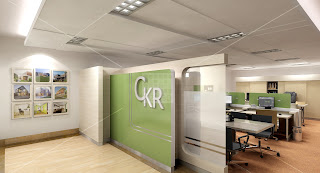Whereas a night scene needs more effort. On one hand, I want to have a dark enough scene so I can show all of the additional lights, but on the other hand, it can't be too dark since we still want to see the buildings details. To solve this, I usually created the scene using Afternoon or dawn image background. So there's still enough light for the sky.
And we also have to design the lighting placement so those additional lighting will make our building looks more beautiful. But generally I use :
- Rectangle Vray Light with Invinsible=on, this will be the main source of light from inside of the building. The size usually big, from the ceiling towards the floor. Or you also can place it from the windows towards inside of the building. For this kind of light, you probably need to raise the subdivision about 15-25, depends on how big is your image output will be, so there won't be any noise.
- Rectangle Vray Light with invinsible=off. I will attach this kind of lamp right to the ceiling, or some lamps on my scene. I also use omni lights for round lamps. For this kind of lamps, I will raise the intensity value about 10-20 units higher than the invinsible lights around it. This so the light won't washed out by other lights.
- IES light, for uplight and downlight. You will need IES light file for this, you can find it from the internet either for free or buy it on the application stores. Personally I got mine from a friend, so, I wouldn't know exactly where to find them. But, for IES light, you need to try out some files to find the one that most suitable for your scene.
 |
| This image created without any Photoshop touch up |
This is the Environment (Sunlight) setting for Vray Night Scene
Good Luck!































